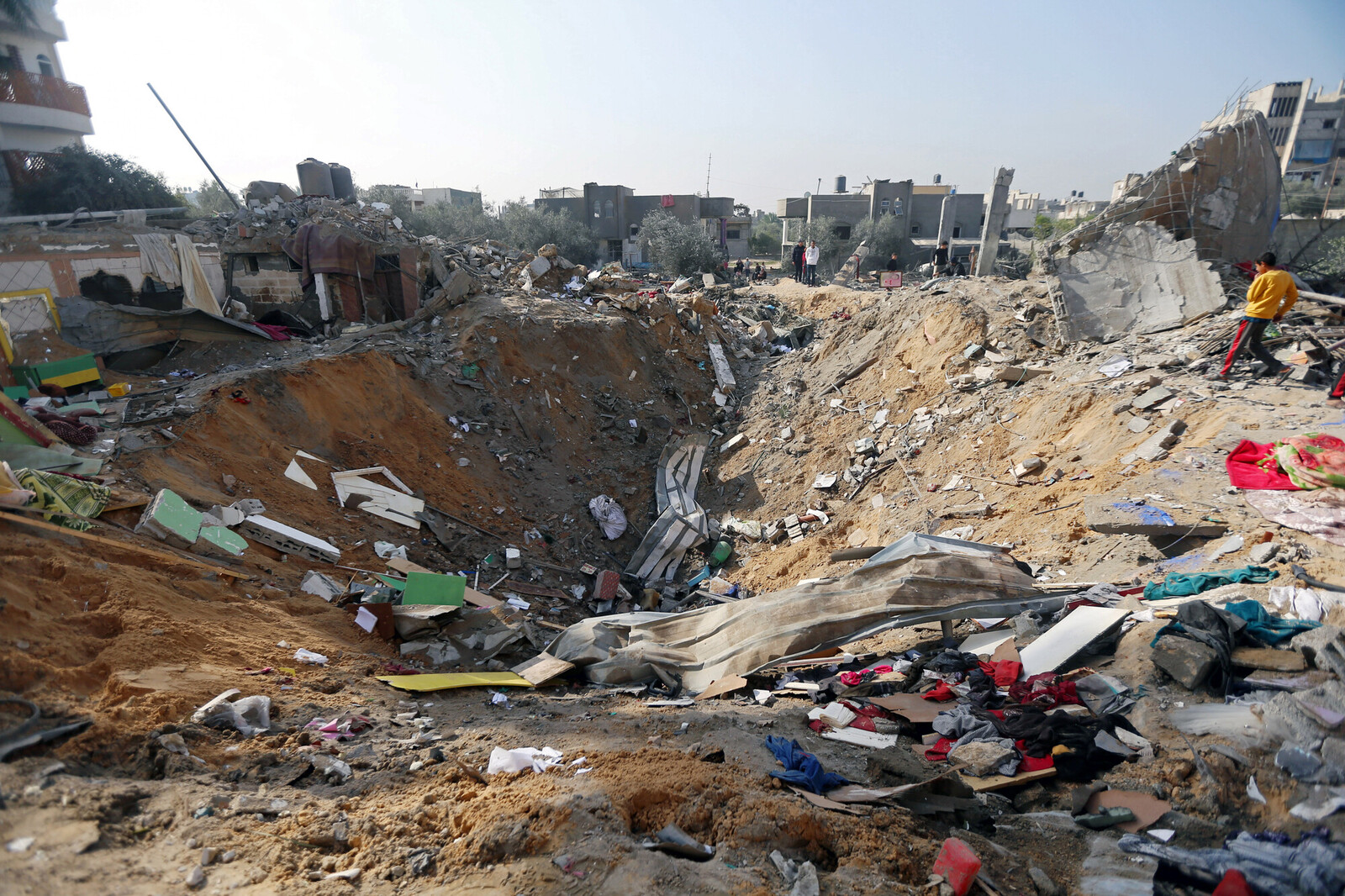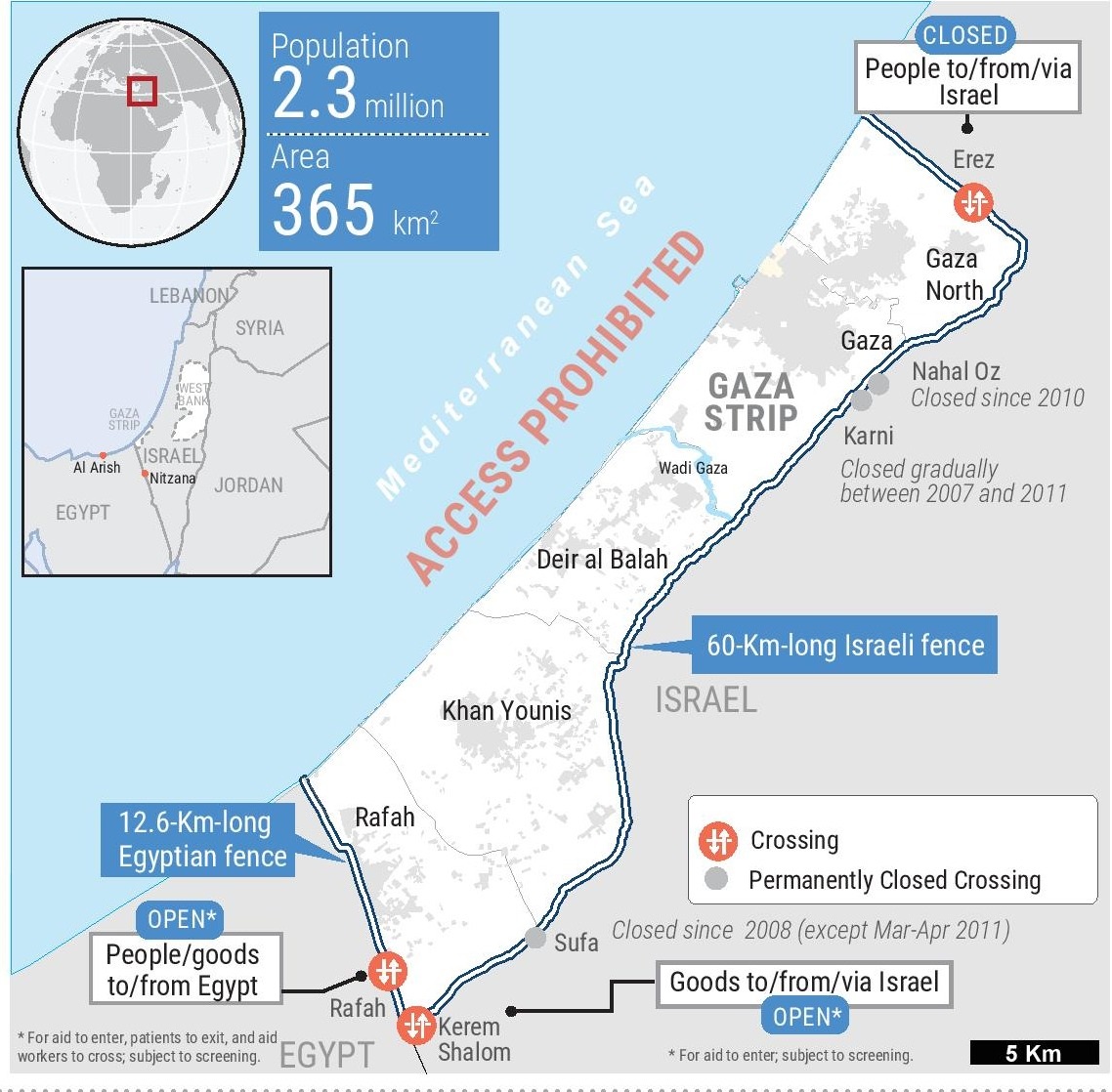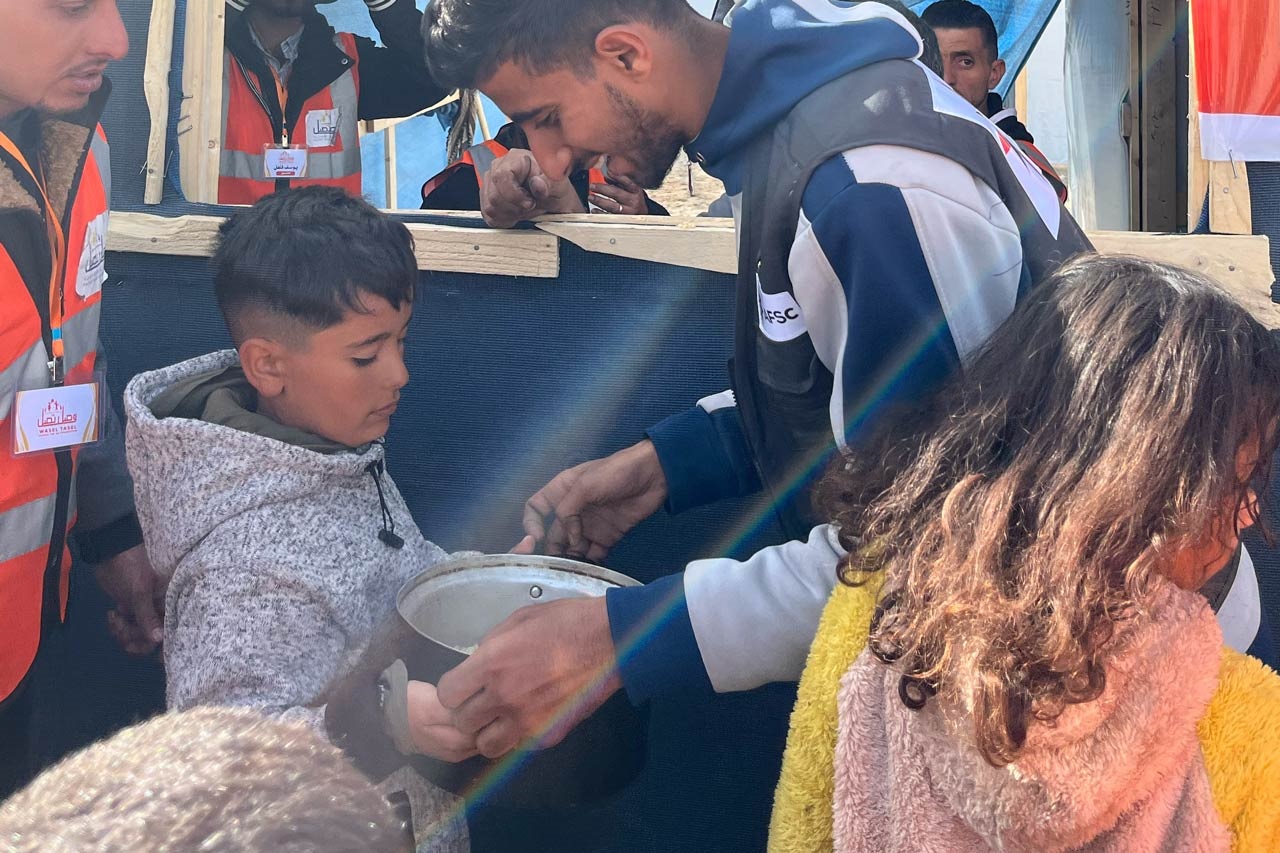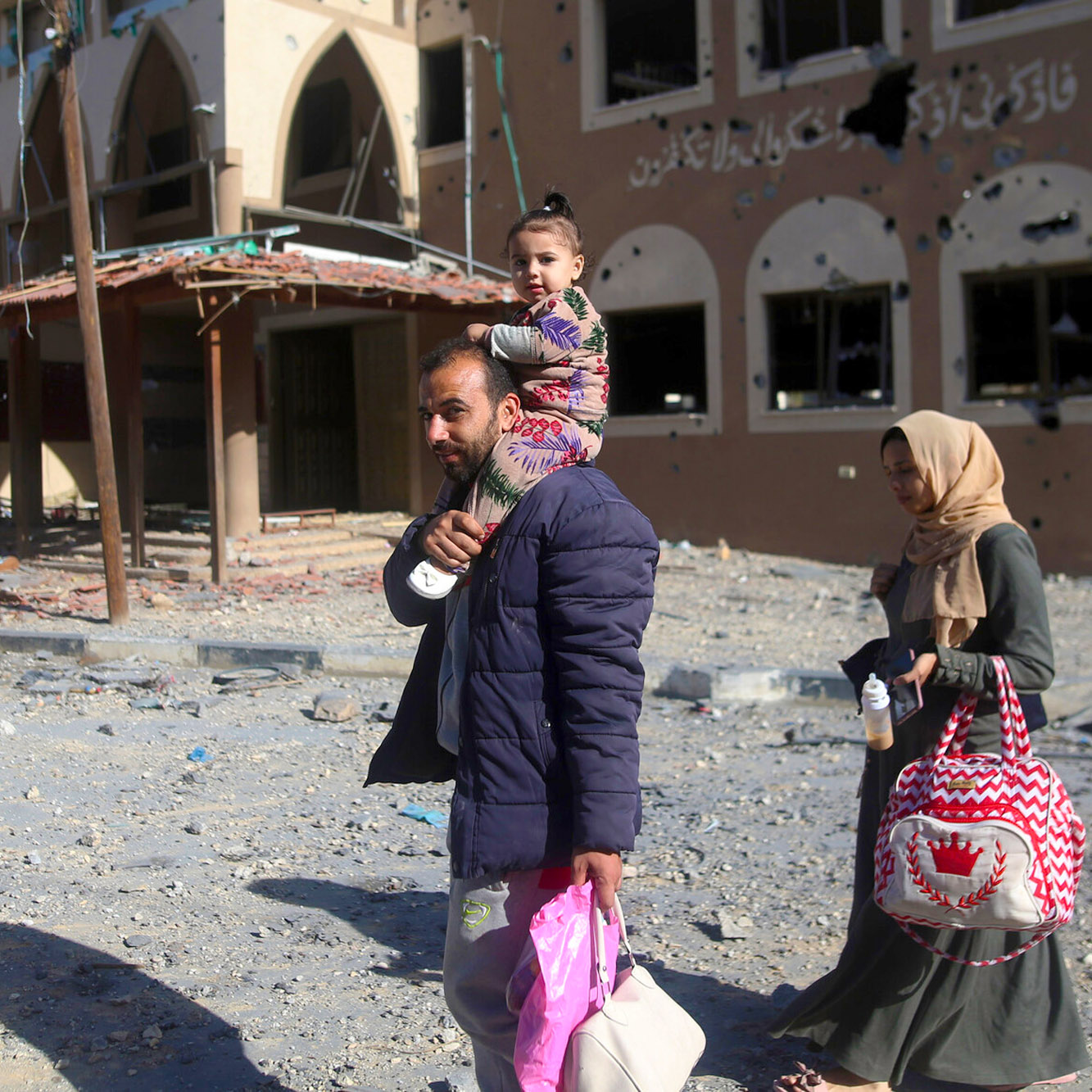
The location of an Israeli air strike on the home of the Harb family in Rafah in December. Mohammed Zaanoun
AFSC has offices and staff in Jerusalem, Gaza, the West Bank, and Jordan. Today, we are providing humanitarian relief to Palestinians in Gaza and the West Bank—as we advocate for a permanent cease-fire and protection for the Palestinian people.
Here’s the latest from our Middle East team on the situation facing Palestinians and how AFSC is responding to the crisis.
By the numbers: The human toll since Oct. 7
GAZA
• 28,663+ killed (70% women and children)
• 10,000+ buried under the rubble
• 68,395+ injured
• 2 million displaced
• 6,000+ arrested
• 70% of homes and other structures partially or completely destroyed
WEST BANK
• 389+ killed
• 4,499 injured
• 2,549 displaced
• 6,000+ arrested
• 445 homes and other structures partially or completely destroyed

After 142 days of Israeli aggression, the situation in Gaza is catastrophic and continues to worsen exponentially, in a context where needs were already dire prior to the current escalation. The total population of Gaza—2.3 million Palestinians—is in urgent need of help. About 200 people are killed daily. Most of the population has been forcibly displaced multiple times, including AFSC staff.
The Israeli government is now using starvation as a weapon of war. The intentional destruction of health facilities—and obstructing access to them—is an increasingly common tactic being used equally in Gaza and the West Bank. The indiscriminate killing, bombardments, and the targeting and destruction of civilian protected areas and personnel have become the norm—all calculated to bring about the physical destruction of Gaza, serious bodily and mental harm, and an overwhelming human loss that has never been registered in any conflict in history at such speed.
More forced displacement and high risk of ethnic cleansing: Areas classified as safe continue to be hit. That is forcing more displacement of the population to the southern border city of Rafah, which now hosts more than 1.5 million Palestinians. Israeli forces surrounded and launched a large-scale operation in the city of Khan Younis weeks ago, causing mass casualties and the damage and destruction of civilian infrastructure, mostly hospitals and UNRWA shelters. Thousands of displaced people taking shelter in and around these protected spaces have been trapped for weeks now.
At the same time, Israel has increased its strikes on the city of Rafah and is threatening a ground invasion. Rafah is the last place in Gaza that has not yet been invaded and is also the key entry and distribution point for humanitarian aid. An Israeli invasion of Rafah will have catastrophic consequences. The threat has created a panic situation among the people sheltering in Rafah. They don’t know what to do and there is no place to go. After Rafah, there is nowhere to escape to except the sea or crossing the border toward Egypt.
See AFSC’s statement denouncing a potential invasion.
Read this interview with AFSC’s Serena Awad in Rafah, who discusses the situation facing displaced Palestinians in Gaza.
Severe overcrowding: In Rafah, people are sleeping in the streets, out in the open. Due to the extreme overcrowding in Rafah city, the roads are so congested that trucks cannot operate, further hampering efforts to distribute humanitarian aid.
The severe overcrowding—together with the impeded access to health and medical supplies, the lack of food and clean water, and poor living conditions—have increased the risk of death for many.
Hunger and starvation as a weapon of war: Currently, every single person in Gaza is hungry. A quarter of the population is starving and struggling to find food and drinkable water, and famine is imminent. Gazans now make up 80% of all people facing famine or catastrophic hunger worldwide, marking an unparalleled humanitarian crisis in Gaza amid Israel’s continued bombardment and siege.
The Famine Review Committee (FRC)—which was activated due to evidence surpassing the acute food insecurity Phase 5 (catastrophic threshold) in Gaza—warns that the risk of famine increases daily amid intense conflict and restricted humanitarian access. Between Dec. 8 and Feb. 7, Gaza’s entire population was classified in IPC Phase 3 or above (crisis or worse). This is the highest share of people facing high levels of acute food insecurity that the FRC has ever classified for any given area or country.
The impacts on children, pregnant and breastfeeding women, and the elderly are a particular source of concern. Pregnant women are not receiving adequate nutrition and healthcare, putting their lives at risk. In addition, all children under five – 335,000 – are at high risk of severe malnutrition.
AFSC’s staff has reported there is no fruit available, and fresh food is running out of the markets. There is also no formula for newborns, which will lead to more deaths.
Obstructing access to health is another form of genocidal intent: The scale and severity of attacks on health care and humanitarian health care providers—in addition to violations against medical missions in the Gaza Strip and the West Bank—have a huge impact on the survival of the Palestinian population. They represent another form of genocidal intent.
Humanitarian and health workers continue to face enormous challenges and risks to serve people in need of urgent assistance and save lives. The persistent siege of hospitals remains a major challenge. Hospitals that are still operating are overwhelmed and lack even the most basic medical supplies. Between Oct. 7 and Feb. 12, there were 378 attacks on health care across Gaza, affecting 98 health facilities and 98 ambulances, according to WHO.
Lack of humanitarian access: Although there are now two corridors (Egyptian and Jordanian) and two crossings open for humanitarian aid, the increased limitations and a more exhaustive scanning by Israeli authorities have actually reduced the number of trucks entering daily.
Since Jan. 24, Israeli protesters have attempted to block the entry of humanitarian aid through the Kerem Shalom/Karem Abu Salem crossing, holding up the trucks for several hours. At the same time, Israel started limiting the number of trucks that were allowed into Gaza hampering the access of aid even more.
Further, most humanitarian missions’ requests to access areas to the north of Wadi Gaza and the Middle have been denied. When approved, they are often obstructed by the Israeli army at checkpoints or aren’t allowed to operate because of the high insecurity of the situation.
Rising public health concerns: The lack of medical supplies, clean water, food, and other essential supplies—combined with poor living conditions, severe overcrowding in shelters, and the disruption of health, water, and sanitation systems—have increased the risk of communicable diseases. There are grave concerns over waterborne diseases due to water consumption from unsafe sources. Diarrhea and respiratory conditions are alarming. And there are also rising cases of influenza, chicken pox, meningitis, jaundice, impetigo acute respiratory infections, skin infections, and hygiene-related conditions like lice.
By Dec. 12, the Ministry of Health had documented 360,000 cases of infectious diseases in shelters, noting that the actual number is believed to be higher. It has also identified 14 diseases with epidemic potential and fears an outbreak due to the huge shortage of medicines and vaccinations to mitigate infectious diseases.
Vulnerable groups in difficult conditions: Several groups are especially vulnerable due to the lack of proper shelter, health and basic services. That includes people with disabilities; women who are pregnant, have recently given birth, or are breastfeeding; people who are recovering from injuries or surgeries; seniors; children, especially newborns; and those with compromised immune systems.
About 183 women deliver daily, most in tents and other challenging conditions. That, together with severe malnutrition, can lead to the death of the mother and/or the baby. Malnutrition among children and pregnant and breastfeeding women (PBW) remains a significant concern, amid a lack of functioning health and sanitation systems and increasing food insecurity. Chronic malnutrition for children who do survive will result in weaker immune systems, putting them at greater risk for infections and long-term physical, mental, and cognitive consequences.
Education denied: For more than four months, over 625,000 students and 22,564 teachers have been deprived of education and a safe place. Thousands of learners and education personnel are among the more than 25,000 people who have reportedly been killed. All UNRWA schools in the Gaza Strip have closed–most turned into shelters– depriving the 300,000 children who attended them of their education.

An open-air soup kitchen operated by AFSC and partners. AFSC Gaza
AFSC’s emergency relief efforts
In Gaza, AFSC has provided emergency relief to displaced people in the Khan Yunis and Rafah regions of Gaza, reaching 161,730 people.
Our staff, working with partners, have also provided:
- Food for 82,804 people. This includes hot meals, food parcels, and fresh vegetables.
- Drinking water for 63,816 people.
- Hygiene kits for 2,270 women and girls and 200 seniors. This includes soap, toothbrushes, toothpaste, women's hygiene products, and other supplies.
- Recreational activities for 12,640 children.
We are also sending additional aid through Egypt into Gaza when Israeli authorities allow it. So far, we have procured six trucks containing food, medicine, as well as blankets and winter clothes for families. More recently, we procured a seventh truck (containing mattresses, sandals, and underwear) to send through Jordan.
Read more about AFSC’s emergency relief.
In the West Bank, Palestinians are increasingly facing arbitrary killings and detentions, home demolitions, daily Israeli army raids, and other human rights violations. Those released from detention have reported the violations committed against detainees inside Israeli prisons, including systematic torture and abuse and the forcible disappearance of Gazan detainees.
Israeli military raids are happening now on a daily basis throughout the West Bank. The Israeli army has been applying the same tactic as in Gaza, obstructing access to health, shooting civilians trying to reach medical facilities, and attacking ambulances. Since Oct. 7, there have been at least 537 Israeli settler attacks against Palestinians, according to the U.N. Office for the Coordination of Humanitarian Affairs.
Over 150,000 workers from the West Bank, previously employed in Israel and settlements, have lost their jobs due to firing or restricted crossings.
AFSC has supported 168 patients from Gaza and their relatives who were receiving treatment in Jerusalem and were forced to relocate to Ramallah during the war. We assisted patients with medical needs and winterization items. Working with partners, we are now providing patients and their families hot meals daily.
How you can help
Contact Congress today: Urge your representatives to call for a total cease-fire and humanitarian access to Gaza.
Give to AFSC’s Gaza emergency response: Your donation will bring humanitarian relief and support ongoing efforts to stop the violence, address its root causes, and build conditions for peace.
